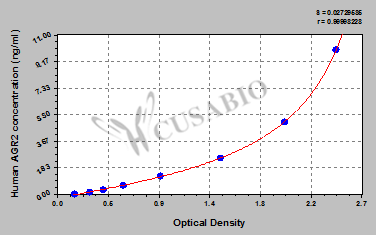The ELISA Kit is designed for quantitatively measuring human AGR2 levels in samples, including serum, plasma, or tissue homogenates. It uses the sandwich enzyme immunoassay technique in combination with the enzyme-substrate chromogenic reaction to quantify the analyte in the sample. The color develops positively to the amount of AGR2 in samples. The color intensity is measured at 450 nm via a microplate reader.
AGR2 is a dimeric protein disulfide isomerase family member that plays a vital role in oxidative protein folding in the endoplasmic reticulum (ER). It acts as a chaperone that mediates the formation of disulfide bonds, catalyzes the cysteine-based redox reactions, and assists the quality control of proteins. AGR2 is involved in several signal transduction pathways that are essential for cell survival. Accumulating evidence has shown that AGR2 is a pro-oncogenic protein implicated in tumorigenesis and cancer progression. Overexpression of AGR2 has been reported in multiple solid human tumors, including breast, prostate, ovarian, lung, esophageal, gastric, colorectal, and pancreatic cancers, and has been associated with adenocarcinoma growth, cell metastasis, and drug resistance.






